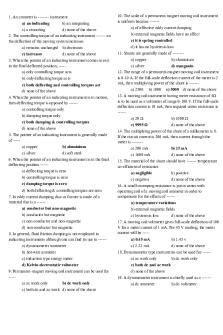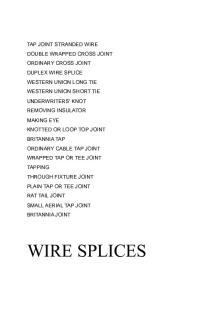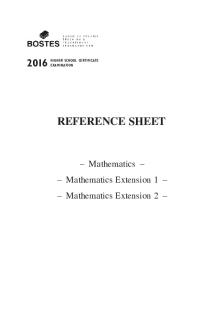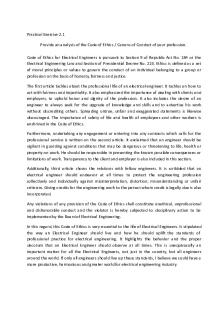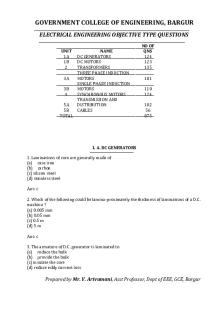Electrical measuring instruments for Electrical engineering PDF

| Title | Electrical measuring instruments for Electrical engineering |
|---|---|
| Course | Electrical Engineering |
| Institution | University of Calicut |
| Pages | 5 |
| File Size | 194.3 KB |
| File Type | |
| Total Downloads | 34 |
| Total Views | 142 |
Summary
Electrical measuring instruments study materials for electrical engineering students. It helps competitive exams. This is multiple choice questions and answers...
Description
1. An ammeter is -------- instrument a) an indicating
b) an integrating
c) a recording
d) none of the above
2. The controlling torque of an indicating instrument ------- an the deflection of the moving system increases a) remains unchanged
b) decreases
c) increases
d) none of the above
3. When the pointer of an indicating instrument comes to rest in the final deflected position, ----a) only controlling torque acts b) only deflecting torque acts c) both deflecting and controlling torques act
10. The scale of a permanent-magnet moving coil instrument is uniform because ------a) of effective eddy current damping b) external magnetic fields have no effect c) it is spring controlled d) it has no hysteresis loss 11. Shunts are generally made of -------a) copper
b) aluminium
c) silver
d) manganin
12. The range of a permanent-magnet moving coil instrument is 0-10 A. If the full-scale deflection current of the meter is 2 mA, then multiplying power of the shunt is ------a) 2500
d) none of the above 4. When the pointer of an indicating instrument is in motion, then deflecting torque is opposed by -----a) controlling torque only b) damping torque only c) both damping & controlling torques d) none of the above 5. The pointer of an indicating instrument is generally made of -----
b) 1000
c) 5000 d) none of the above
13. A moving coil instrument having meter resistance of 5Ω is to be used as a voltmeter of range 0-100 V. If the full-scale deflection current is 10 mA, then required series resistance is -----a) 20 Ω
b) 1000 Ω
c) 9995 Ω
d) none of the above
14. The multiplying power of the shunt of a milliameter is 8. If the circuit current is 200 mA, then current through the meter is --------
a) copper
b) aluminium
a) 200 mA
b) 25 mA
c) silver
d) soft steel
c) 1600 mA
d) none of the above
6. When the pointer of an indicating instrument is in the final deflecting position ------
15. The material of the shunt should have ------- temperature co-efficient of resistance
a) deflecting torque is zero
a) negligible
b) positive
b) controlling torque is zero
c) negative
d) none of the above
c) damping torque is zero d) both deflecting & controlling torques are zero 7. In eddy current damping, disc or former is made of a material that is a ------
16. A small swamping resistance is put in series with operating coil of a moving coil ammeter in order to compensate for the effects of -----a) temperature variations
a) conductor but non-magnetic
b) external magnetic fields
b) conductor but magnetic
c) hysteresis loss
c) non-conductor and non-magnetic d) non-conductor but magnetic 8. In general, fluid friction damping is not employed in indicating instruments although one can find its use in -----a) dynamometer wattmeter b) hot-wire ammeter
17. A moving coil voltmeter gives full-scale deflection of 100 V for a meter current of 1 mA. For 45 V reading, the meter current will be ----a) 0.45 mA
b) 1.45 v
c) 2.22 mA
d) none of the above
18. Dynamometer type instruments can be used for ------
c) induction type energy meter
a) ac work only
d) Kelvin electrostatic voltmeter
c) both dc and ac work
9. Permanent-magnet moving coil instrument can be used for ----a) ac work only
d) none of the above
b) dc work only
c) both dc and ac work d) none of the above
b) dc work only
d) none of the above 19. A dynamometer instrument is chiefly used as a ------a) dc ammeter
b) dc voltmeter
d) none of the above
c) wattmeter
20. In a dynamometer type instrument, damping is provided by -----a) air friction
b) eddy currents
c) fluid friction
d) none of the above
21. Dynamometer type -------- has uniform scale a) ammeter
b) wattmeter
c) voltmeter
d) none of the above
b) hot-wire
23. If current through the operating coil of a moving-iron instrument is doubled, the operating force becomes ----c) one-half time
d) three times
b) 1 A
c) 3 A
d) 2 A
25. For measuring high values of alternating current with a dynamometer ammeter, we use a -----a) shunt
c) Dynamometer
d) None of the above b) ammeters only
a) voltmeters only
c) both ammeters and voltmeters d) wattmeters only 34. An electric pyrometer is an instrument used to measure --b) frequency
35. The best type of meter movement is ----- movement a) iron-vane
b) D’Arsonval
c) dynamometer
d) none of the above
a) Moving-iron
b) Hot-wire
c) Dynamometer
d) Permanent-magnet moving coil 37. In induction type ammeter, --------- damping is provided a) air friction
b) eddy current
c) fluid friction
d) none of the above
a) induction voltmeter b) induction wattmeter d) induction ammeter
a) uniform
b) log
c) squared
d) none of the above
27. The full-scale voltage across a moving coil voltmeter is about -----c) 100 V
b) Moving-iron
c) induction watt-hour meter
26. Hot-wire instruments have ------ scale
b) 5 V
a) D’Arsonval
38. The most commonly used induction type instrument is ----
b) multiplier
c) potential transformer d) current transformer
a) 10 V
32. ---------- movement is most expensive
36. -------- instruments are most sensitive
24. The full-scale deflection current of a moving coil instrument is about ----a) 50 mA
d) moving iron
c) high temperatures d) none of the above
d) none of the above
b) four times
c) hot-wire
a) phase
c) permanent-magnet moving coil
a) two times
b) electrostatic
33. Electrostatic instruments are used as ------
22. The instrument in which springs provide the controlling torque as well as serve to lead current into and out of the operating coil is ----- instrument a) moving-iron
a) permanent-magnet moving coil
d) 50 mV
28. Moving-iron instruments have ------ scale
39. All voltmeters except ------ voltmeters are operated by the passage of current a) moving-iron
b) electrostatic
c) dynamometer
d) permanent-magnet moving coil 40. The watt-hour meter is ----- instrument
a) uniform
b) squared
a) an integrating
b) an indicating
c) log
d) none of the above
c) a recording
d) a transformer
29. The range of a moving-iron ac ammeter is extended by -----a) a shunt
b) a multiplier
c) changing number of turns of operating coil
41. Indicating instruments are assumed to be most accurate --part of scale a) at beginning
b) at finishing
c) at half of full
d) none of the above
42. -------- meter will be the most sensitive
d) none of the above 30. To measure high-frequency currents, we mostly use ------ammeter
a) 50 mA
b) 100 mA
c) 50 μA
d) 1 μA
43. On a simple ohmmeter, the 0 Ω mark is ------ of the scale
a) hot-wire
b) dynamometer
a) far left
b) far right
c) moving-iron
d) thermocouple
c) in the middle
d) none of the above
31. For the measurement of high direct voltage (say 10 kV), one would use ------- voltmeter
44. If a wattmeter connected in circuit gives down scale reading, then we normally change connection of ------
a) current coil
a) 10 A
b) potential coil
c) both current and potential coils
a) current coil
45. A permanent magnet moving coil ammeter is connected in 50 Hz ac circuit in which 5A current is flowing. The meter will read b) 5 A
c) 2.5 A
c) 15 A
d) none of the above
46. A permanent magnet moving coil ammeter is connected in 50 Hz ac circuit in which 5A current is flowing. If the meter remains connected in the circuit for some time a) meter pointer gives full-scale deflection b) meter pointer starts oscillating c) meter coil is burnt d) none of above 47. A permanent magnet moving coil ammeter is connected in 50 Hz ac circuit in which 5A current is flowing. The frequency of ac is 0.1 Hz, the pointer will
b) potential coil
c) current coil or potential coil d) none of the above 76. Induction wattmeter can measure a) ac power only
b) dc power only
c) both ac and dc power d) none of the above 77. To measure ac as well as dc power, we use a) induction wattmeter b) dynamometer wattmeter c) none of the above 78. In a single phase energy meter, braking torque is provided by
a) rise from zero and then fall back
a) permanent magnet b) air friction
b) read zero
c) fluid friction
c) red full-middle
d) none of the above
48. On a simple ohmmeter, the infinity Ω mark is ----- of the scale a) far left
b) far right
c) in the middle
d) none of the above
49. The instrument used in an ohmmeter is generally a) moving-iron type
d) 20 A
66. In a dynamometer wattmeter, the moving coil is the
d) none of the above
a) 0 A
b) 30 A
b) hot-wire type
c) permanent magnetic moving coil type d) dynamometer type 50. When the terminals of a series ohmmeter are opencircuited, the pointer reads
d) none of the above
79. The meter constant of an energy meter is 1500 rev/kWh, the disc makes 3000 revolutions in a given time. The energy consume is a) 4 kWh
b) 1 kWh
c) 3 kWh
d) 2 kWh
80. A 230 V, 50 Hz single-phase energy meter has a load current of 10 A at pf of 0.8 lagging. The energy consumed by the load in 2 minutes is a) 1.2 kWh
b) 0.06 kWh
c) 2.4 kWh
d) 4.2 kWh
81. A 230 V, 50 Hz single-phase energy meter has a load current of 10 A at pf of 0.8 lagging. If the disc makes 72 revolutions per minute, what is the meter constant?
a) zero
b) infinity
a) 600 rev/kWh
b) 900 rev/kWh
c) a high resistance
d) none of the above
c) 1200 rev/kWh
d) none of the above
51. Out of the following, the most accurate measurement of unknown resistance will be by a) potentiometer
b) ohmmeter
c) voltmeter and ammeter d) wheatstone bridge 52. A 50 V range voltmeter has a sensitivity of 20 kΩ/V. The total resistance of the voltmeter is a) 2.5 kΩ
b) 0.4 kΩ
c) 10 kΩ
d) 1 MΩ
58. The scale of an ohmmeter is a) linear
b) non-linear
c) linear and non-linear d) none of above 65. Resistance of an ammeter having range 0-5A is 1.8 Ω. It is shunted by a resistor of 0.2 Ω. What is the effective current when the pointer reads 2 A?
82. In a single phase energy meter, if the brake magnet is moved towards the centre of the spindle, the disc speed a) increases
b) decreases
c) remains same
d) none of the above
83. An energy meter whose meter constant is 1500 rev/kWh makes 20 revolutions in 30 seconds. The load in kW is a) 3.2 kW
b) 0.8 kW
c) 6.4 kW
d) 1.6 kW
84. A 230 V single phase energy meter has a constant load current of 4 A passing through if for 5 hours at unity power factor. If the meter makes 1104 revolutions during this period, the meter constant is a) 480 rev/kWh
b) 240 rev/kWh
c) 320 rev/kWh
d) 960 rev/kWh
85. A 230 V single phase energy meter has a constant load current of 4 A passing through if for 5 hours at unity power factor. If the load pf is 0.8, the number of revolutions the disc will make in above time (5hours) is about a) 464
b) 572
c) 883
d) 774
86. The full-scale deflection current of a permanent magnet moving-coil (PMMC) meter is 1 mA and the coil resistance is 50Ω. The least voltage that can be measured with this meter is a) 50 mV
b) 25 mV
c) 100 mV
d) none of the above
87. If the full-scale current of a meter is 50 μA, then its sensitivity is a) 1000 Ω/V
b) 20,000 Ω/V
c) 10,000 Ω/V
d) data insufficient
88. A 100 V full-scale, 100 Ω/volt meter has a full-scale deflection current of a) 0.5 mA
b) 2 mA
c) 3.5 mA
d) 1 mA
89. With a potentiometer, null points are obtained at 140 cm and 180 cm with cells of emf 1.1 V and one of the unknown emf respectively. The unknown emf is a) 1.1 V
b) 1.8 V
c) 1.41 V
d) 1.6 V
90. In a potentiometer experiment, it is found that no current flows through the galvanometer when the terminals of the cell are connected across 52 cm of potentiometer wire. If the cell is shunted by a resistance of 5Ω, the balance point is found at 40 cm of the wire from the same end. The internal resistance of the cell is a) 1.5 Ω
b) 2.5 Ω
c) 3 Ω
d) 4.5 Ω
91. A potentiometer wire is 10 m long. It has a resistance of 20 Ω. It is connected in series with a battery of e.m.f. 3V and negligible resistance and a resistance of 10 Ω. The potential gradient along the wire in volt/meter is a) 0.4
b) 0.2
c) 0.1
d) 0.3
92. In a potentiometer experiment, it is found that no current flows through the galvanometer when the terminals of the cell are connected across 125 cm potentiometer wire. On shunting the cell by 2Ω resistor, the balancing length is reduced to half. The internal resistance of the cell is a) 3 Ω
b) 6 Ω
c) 1 Ω
d) 2 Ω
93. A moving coil galvanometer has a sensitivity of 60 divisions/amp. When a shunt is used, its sensitivity becomes 10 div/amp. What is the value of the galvanometer is 20 Ω? a) 2 Ω
b) 6 Ω
c) 4 Ω
d) 1 Ω
94. Which of the following is likely to have the largest resistance? a) moving coil galvanometer b) voltmeter of range 10 V
c) ammeter of range 1 A d) a copper wire of length 1m and diameter 3 mm 95. If 2% of the main current is to be passed through a moving coil galvanometer of resistance G, the resistance of the shunt required is a) G/49
b) G/50
c) 49 G
d) 50 G
96. A galvanometer has a resistance of G ohms. It is shunted by a resistance of S ohms. How much resistance should be added so that the main current remains unchanged? 𝑆
b)
a) 𝑆+𝐺
𝐺 𝐺+𝑆
c)
𝑆𝐺
d)
𝐺+𝑆
𝑮𝟐 𝑮+𝑺
97. In a moving coil galvanometer, the deflection becomes one-half when the galvanometer is shunted by a 20 Ω resistor. The galvanometer resistance is a) 10 Ω
b) 40 Ω
c) 20 Ω
d) 5 Ω
98. It is required to convert a moving coil galvanometer of current range 15 mA and voltage range 750 mV into an ammeter of range 2.5 A. What is the value of shunt resistance required? b) 1.5 Ω
a) 0.3 Ω
c) 3.4 Ω
d) 0.5 Ω
99. A moving coil galvanometer of resistance 25 Ω is connected to a source of emf 2V with a resistance of 3 kΩ. Full-scale deflection of 30 units is obtained. When 3 kΩ resistance is replaced by R, the deflection becomes 20 units. The value of R is approximately a) 2.3 kΩ
b) 4.2 kΩ
c) 3.8 kΩ
d) 4.5kΩ
100. A moving coil galvanometer with a scale divided into equal divisions has a current sensitivity of 10 divisions per m A and voltage sensitivity of 50 divisions per m V. To convert it into an ammeter of range 5 A, the necessary shunt resistance required is a) 0.1 Ω
b) 5/4999 Ω
c) 0.03 Ω
d) 3/283 Ω
101. Deflection of a moving coil galvanometer falls from 50 divisions to 20 divisions when a 12 Ω shunt is applied. Galvanometer resistance is b) 6 Ω
a) 18 Ω
c) 9 Ω
d) 24 Ω
102. A voltmeter of resistance 998 Ω is connected in series with a cell of emf 2 V and internal resistance 2 Ω. The percentage error in the reading of voltmeter is a) 1%
b) 0.2%
c) 2%
d) 0.1%
103. In an ammeter, 5 percent of main current passes through the galvanometer. If resistances of the galvanometer and shunt are G and S respectively, then, a) 𝑺 =
𝑮
b) 𝑆 − 𝐺 =
𝟏𝟗 1
c) 𝐺 − 𝑆 = 19
d) 𝐺 =
𝑆 19
1 19
104. To send 10% of main current through a moving coil galvanometer of resistance 99 Ω, the value of shunt resistance required is a) 33 Ω
b) 9.9 Ω
c) 22 Ω
d) 11 Ω
105. The sensitivity of a moving coil galvanometer is 60 divisions/ampere. When a shunt is used, the sensitivity becomes 10 divisions/ampere. If the galvanometer resistance is 20 Ω, the value of shunt is a) 15 Ω
b) 20 Ω
c) 4 Ω
d) 5 Ω
106. A 20 μA, 200 mV meter movement is used to make a 25 V voltmeter. What is the sensitivity of the meter? a) 25 kΩ/V
b) 50 kΩ/V
c) 100 kΩ/V
d) 75 kΩ/V
107. A 20 μA, 200 mV meter movement is used to make a 25 V voltmeter. What is the value of multiplier resistance? a) 620 kΩ
b) 1240 kΩ
c) 830 kΩ
d) none of the above
108. A 20 μA, 200 mV meter movement is used to make a 25 V voltmeter. What is the total resistance of the voltmeter? a) 1250 kΩ
b) 625 kΩ
c) 2500 kΩ
d) 150 kΩ
b) 1.5 kΩ
c) 12 kΩ
d) 3 kΩ
110. A 10 V range voltmeter is rated for 50 μA full-scale current. The total resistance of the voltmeter is a) 100 kΩ
b) 200 kΩ
c) 300 kΩ
d) 400 kΩ
b) maximum quantity it can measure d) none of the above 112. The torque/weight ratio of an instrument indicates d) fidelity
113. A current 𝑖 = (10 + 10 sin 𝑡) 𝐴 is passed through an ideal moving iron type ammeter. Its reading will be a) zero
b) 10 A
c) √2 A
d) √𝟏𝟓𝟎 A
114. A high frequency ac signal is applied to PMMC instrument. If the rms value of ac signal is 2 V, the reading of the instrument will be a) 2 V
b) zero
c) 2√2 V
116....
Similar Free PDFs
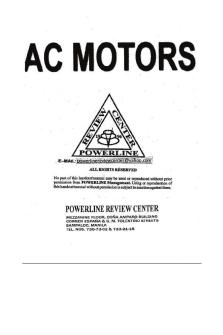
AC Motors101 Electrical Engineering
- 17 Pages

Electrical engineering - Wikipedia
- 18 Pages
Popular Institutions
- Tinajero National High School - Annex
- Politeknik Caltex Riau
- Yokohama City University
- SGT University
- University of Al-Qadisiyah
- Divine Word College of Vigan
- Techniek College Rotterdam
- Universidade de Santiago
- Universiti Teknologi MARA Cawangan Johor Kampus Pasir Gudang
- Poltekkes Kemenkes Yogyakarta
- Baguio City National High School
- Colegio san marcos
- preparatoria uno
- Centro de Bachillerato Tecnológico Industrial y de Servicios No. 107
- Dalian Maritime University
- Quang Trung Secondary School
- Colegio Tecnológico en Informática
- Corporación Regional de Educación Superior
- Grupo CEDVA
- Dar Al Uloom University
- Centro de Estudios Preuniversitarios de la Universidad Nacional de Ingeniería
- 上智大学
- Aakash International School, Nuna Majara
- San Felipe Neri Catholic School
- Kang Chiao International School - New Taipei City
- Misamis Occidental National High School
- Institución Educativa Escuela Normal Juan Ladrilleros
- Kolehiyo ng Pantukan
- Batanes State College
- Instituto Continental
- Sekolah Menengah Kejuruan Kesehatan Kaltara (Tarakan)
- Colegio de La Inmaculada Concepcion - Cebu
